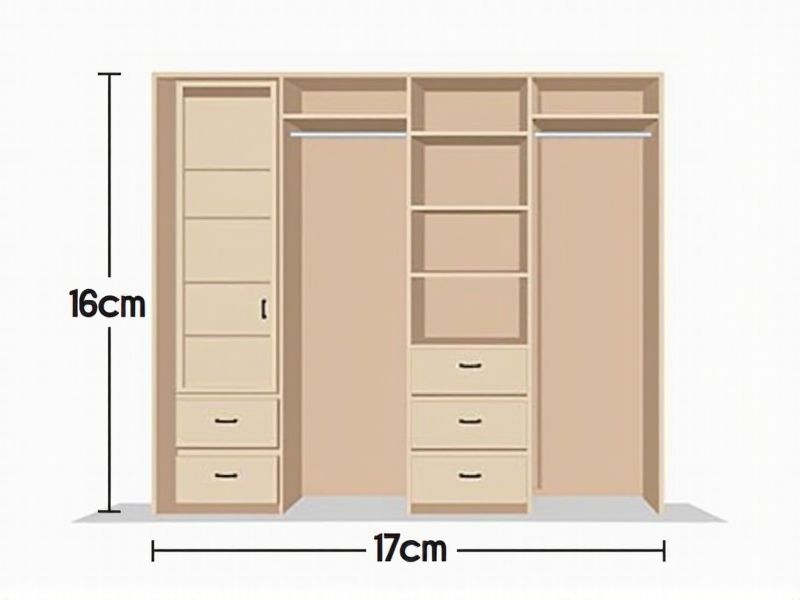
When planning a closet, knowing standard dimensions is essential for maximizing space and functionality. A typical reach-in closet is usually 24 to 30 inches deep to accommodate hanging clothes without them touching the back wall, while the width can range from 3 to 8 feet, depending on the available space. The minimum recommended height for a hanging rod is about 66 inches, ensuring long garments won't touch the floor. Customizing your closet based on these dimensions helps ensure your storage needs are efficiently met and your clothing is kept organized and accessible.
Typical Reach-In Closet Depth
The typical depth for a reach-in closet is approximately 24 inches, allowing for efficient organization and access to your clothing and accessories. This depth accommodates standard hanging rods and shelving while maximizing storage space. For optimal usability, consider incorporating adjustable shelves and drawers within the closet structure. An organized reach-in closet not only enhances functionality but can also increase the overall value of your home.
Average Walk-In Closet Size
The average walk-in closet size typically ranges from 75 to 100 square feet, providing ample space for organized storage. A standard dimension often measures about 6 feet by 10 feet, which accommodates both hanging and shelving options. Incorporating features such as built-in cabinetry can enhance usability, allowing for an estimated 25% more storage efficiency. You can optimize your closet's functionality by planning for various zones, including shoe storage and accessory sections, ensuring everything is easily accessible.
Standard Rod Height
The standard rod height for closets typically ranges from 60 to 72 inches, which allows for optimal hanging space for both short and long garments. For efficient use, consider positioning rods at 66 inches for average needs, ensuring accessibility without compromising space. Using adjustable shelving can improve organization, with recommended shelf heights starting at 12 inches for folded items. For maximized utility, incorporate double hanging rods, allowing for 30% more garment storage in the same linear space.
Typical Shelf Height
A standard closet typically features shelf heights ranging from 12 to 18 inches apart, optimizing storage space for various items. For maximum efficiency, the top shelf is generally positioned 84 inches from the floor, accommodating long-term storage of seasonal clothing and shoes. You can maximize your closet's functionality by installing adjustable shelving that allows customization based on your specific storage needs. With a well-planned layout, you can easily access frequently used items while keeping your closet organized and visually appealing.
Average Shoe Rack Width
The average shoe rack width typically measures around 24 to 36 inches, accommodating various footwear styles without overwhelming your closet space. A well-designed shoe rack can hold anywhere from 6 to 12 pairs of shoes, depending on its height and shelf configuration. By optimizing the width, you can ensure efficient use of your closet area, allowing for easy access and organization. Consider your shoe collection's size and type when selecting a shoe rack to maximize functionality and aesthetics.
Hanging Space For Long Garments
A well-designed closet should allocate a minimum of 60 inches of hanging space for long garments, ensuring that dresses and coats can hang freely without touching the floor. Incorporating adjustable rods allows for customizing the hanging height, accommodating items from full-length dresses to floor-length coats. Consider using uniform hangers, which can save space and maintain organization, as they typically take up about 1 inch of width each. Ensuring sufficient lighting, such as LED strip lights, can enhance visibility and make it easier for you to select long garments efficiently.
Double Hanging Rod Height
The standard height for a double hanging rod in a closet typically ranges from 84 to 96 inches, allowing for effective use of vertical space. The top rod is generally positioned 84 to 90 inches from the floor, accommodating long garments, while the lower rod is set at about 36 to 42 inches, ideal for shorter clothing items. This configuration enables you to maximize storage efficiency by utilizing every inch of height. For optimal organization, ensure the distance between the two rods is approximately 36 inches, providing enough space for hangers and clothing.
Shelf Spacing Guidelines
When designing a closet, adhering to shelf spacing guidelines is crucial for maximizing storage efficiency. Ideally, shelves should be spaced 12 to 16 inches apart for folded items, while 8 to 10 inches is suitable for shoes. For longer garments, such as dresses and coats, maintain a vertical clearance of at least 60 inches to ensure easy access. By considering these spacing recommendations, you can create a functional and organized closet space tailored to your needs.
Depth For Storage Bins
A standard closet typically requires a depth of 24 inches to effectively accommodate storage bins, allowing for easy access and optimal organization. This depth supports a variety of container sizes, from shallow bins that hold accessories to deeper ones for seasonal clothing or bulky items. You can maximize space efficiency by using bins that stack, enabling vertical storage and maintaining a neat appearance. To ensure functionality, consider adjustable shelving that can adapt to your changing storage needs over time.
Optimal Drawer Height
The optimal drawer height for a standard closet typically ranges from 12 to 18 inches, ensuring easy accessibility and efficient organization. For adults, a comfortable opening height is around 36 inches from the floor, aligning with ergonomic design principles. When planning your closet, consider incorporating at least four to six drawers to maximize storage while maintaining functionality. Implementing dividers within these drawers can further enhance organization, helping you separate items like clothing, accessories, and personal belongings effectively.
